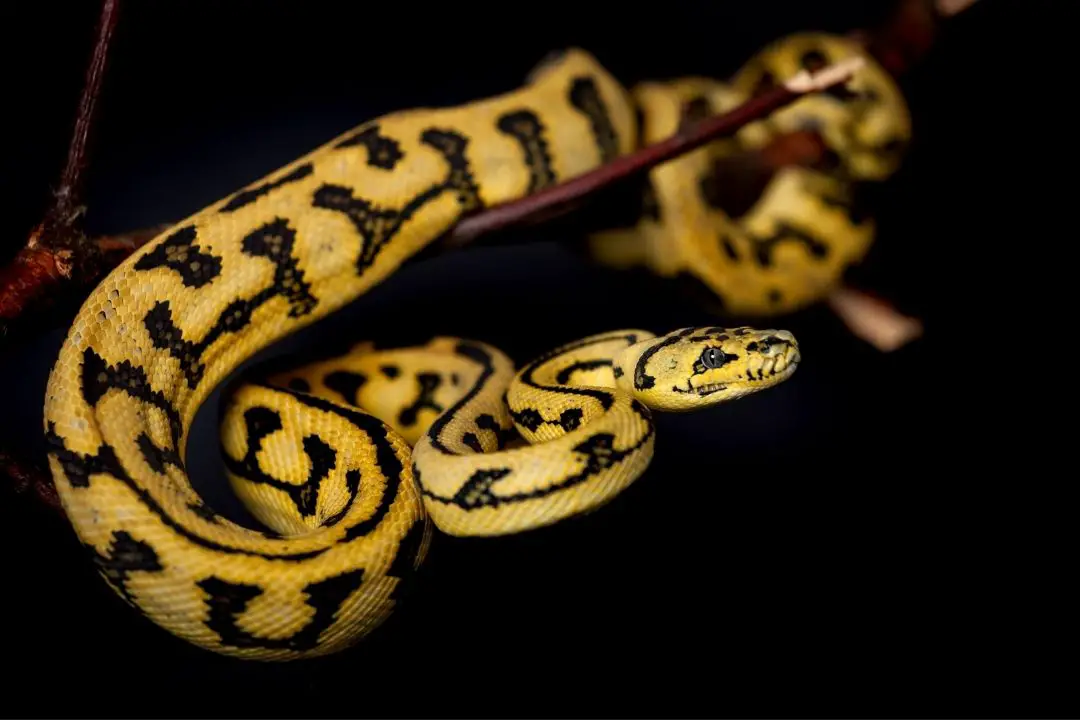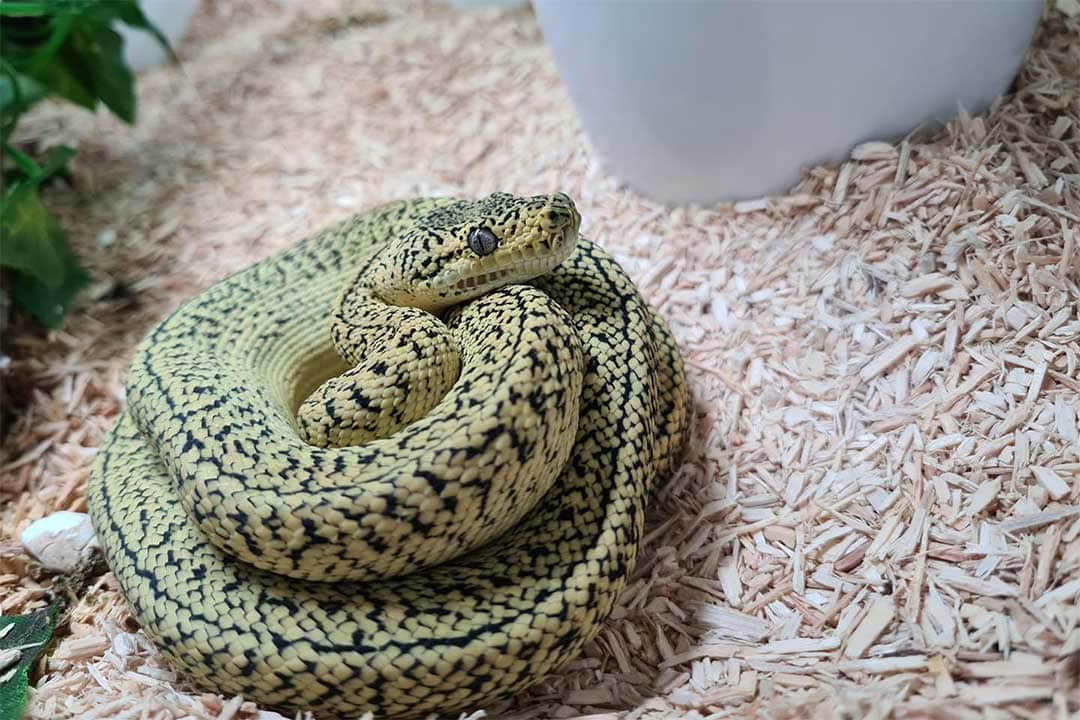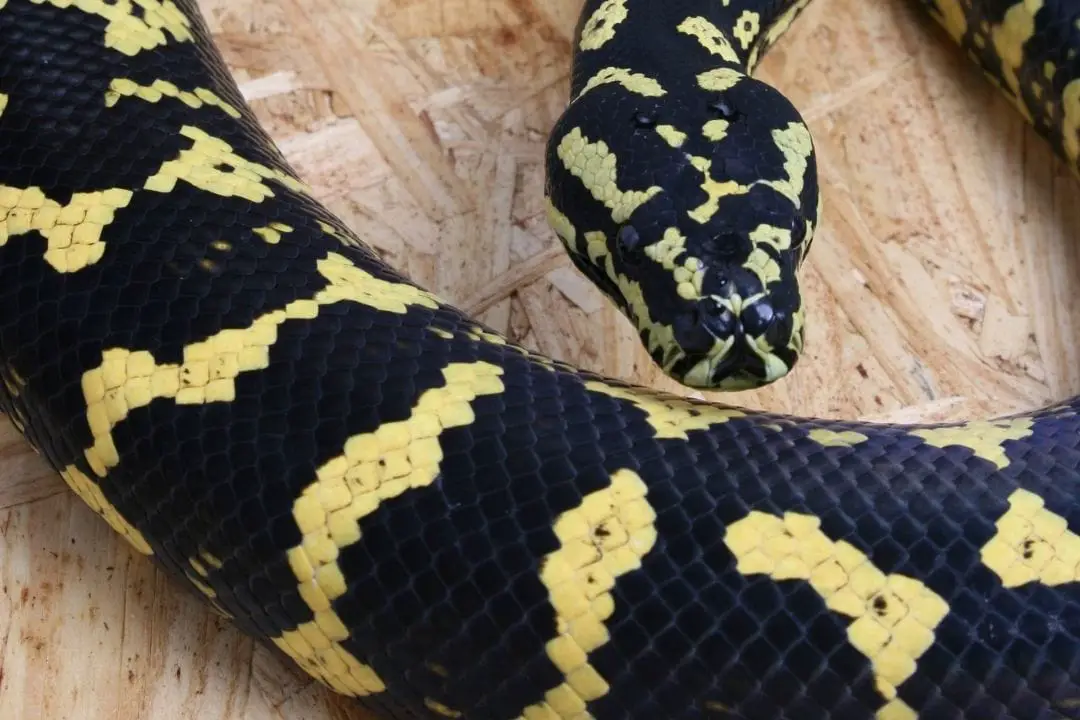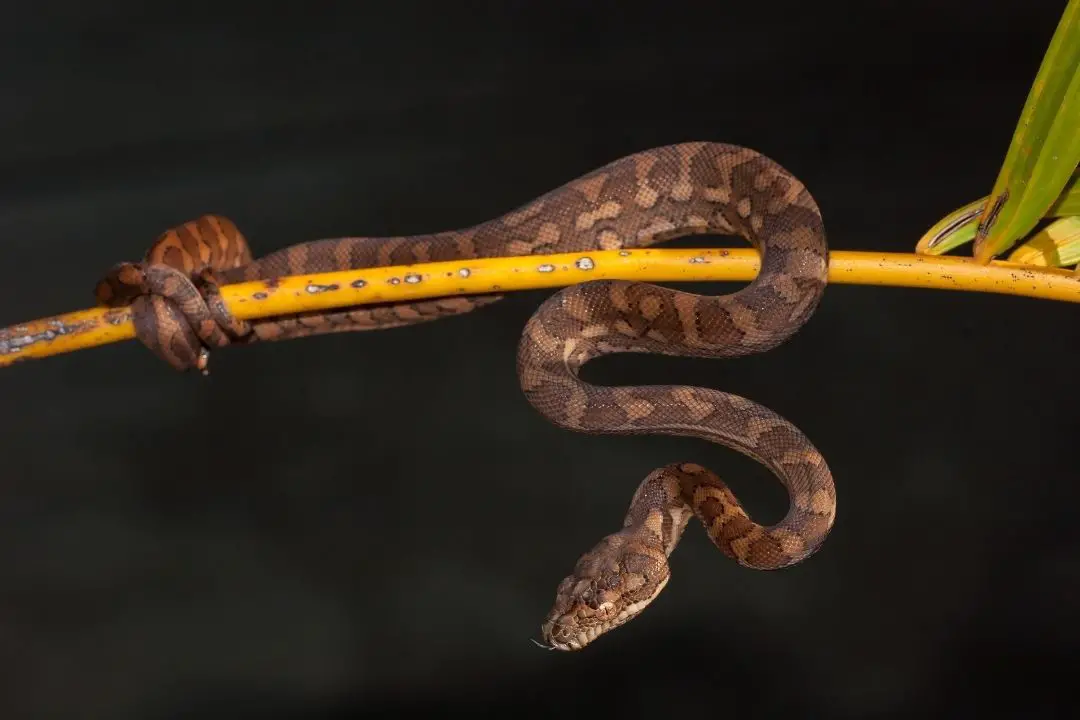The carpet python (Morelia spilota) is a popular pet snake native to Australia and nearby islands such as Papua New Guinea.
5 recognized subspecies live in varied habitats. Each one has a unique look, size, behavior, and needs. Take this care sheet as a guideline and be sure to research the exact subspecies of your snake.
If your breeder crosses the subspecies or doesn’t know, you will need to take it slow and pay a great deal of attention to meet your snake’s needs. Be sure to do your research on this to pick the best subspecies for you.
Please do not purchase a wild-caught carpet python, since they are threatened in some parts of their wild range.
Housing
Carpet pythons are semi-arboreal, need somewhat high heat, and moderate humidity on average. This can vary, but you can learn what your snake needs by observing its behavior.
An animal that is soaking frequently either has mites or needs more humidity. If your carpet python is always on one side of the enclosure, you know that your snake will need temperatures adjusted.
Pay attention and research the native habitat of your snake.
Enclosure
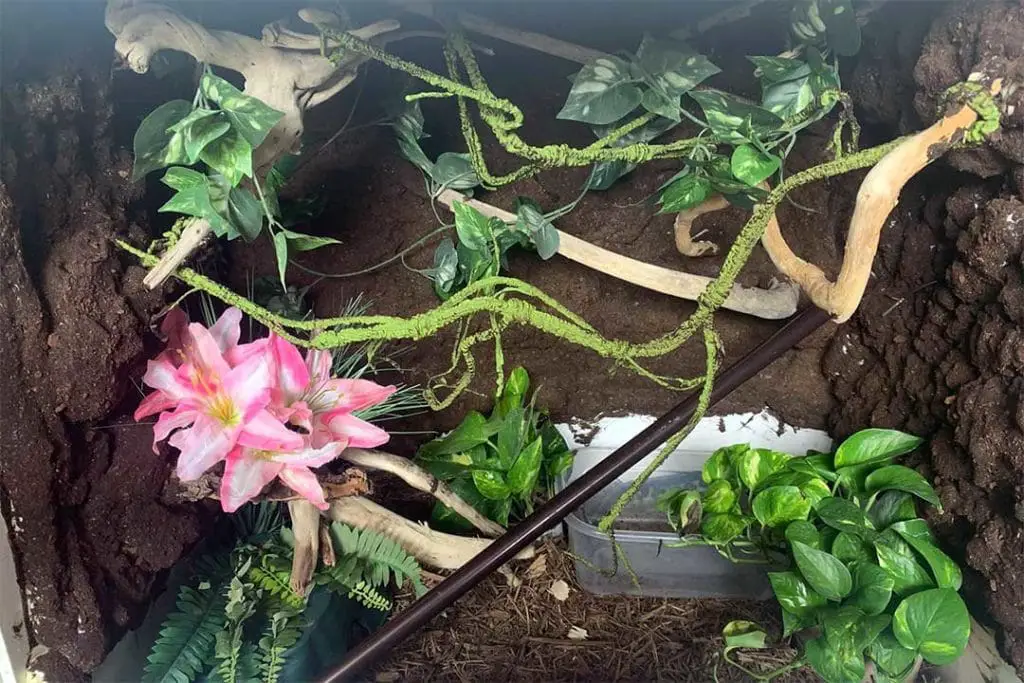
Carpet pythons need plenty of space and height. You need to offer spaces off the floor for this semi-arboreal species. They also need a big water dish and two hides at a minimum.
You need to offer branches for climbing, greenery, and consider offering shelves that your snake can relax on. These could have vines placed to offer more cover.
You should also try to cover the sides of a glass enclosure to help the snake feel more secure.
This species can become quite big, carpet pythons need very large enclosures as adults, so do not get one unless you have the space for a cage that is as long as your snake, half that in width, and about half that in height.
Since they can be large depending on the subspecies, you may need to get a custom enclosure made.
Baby and Juvenile Carpet Python Enclosure
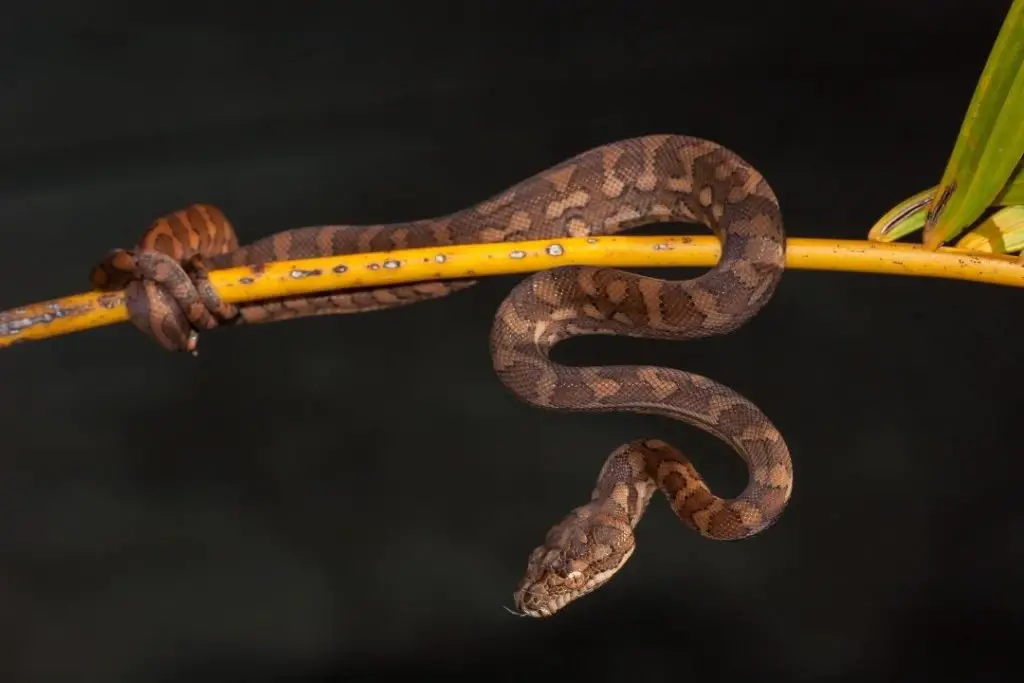
These snakes start at about a foot depending on the subspecies. Hatchling carpet pythons grow pretty quickly, so you want a cage that is at least 36 inches long to hold your snake for any length of time.
This is a great option since it has locking doors, and offers enough length to hold your snake for a good portion of its life. It is also easy to clean and should work well with most heating options.
If your snake seems a bit stressed out from a large enclosure, you can block off part of it until your snake grows.
Adult
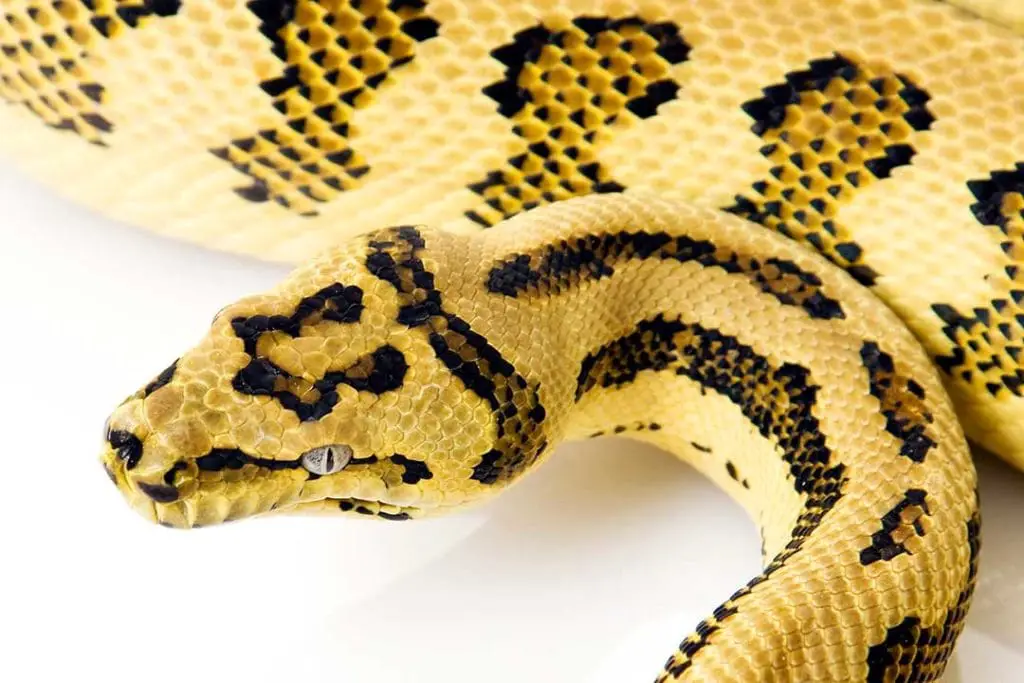
Adult carpet pythons are very large snakes. Some subspecies can be up to 10 feet or longer. You will need a massive cage.
The general rule for snakes is the length of the snake by half its length for width and height.
This gives this active animal plenty of room. The smaller subspecies typically stick around 5 feet, so if you don’t have a lot of space look for a breeder who can guarantee that your snake will stay on the smaller side.
This is a good option for a smaller snake. Since most subspecies don’t require high humidity, you could build your own enclosure out of wood. All snake enclosures need ventilation, secure doors, and are easy to keep clean. For this species, try to add shelving to give your snake places to climb and stay off the floor of the cage.
Substrate
For substrate, you do not need much. Paper towels, unprinted newspaper, and reptile paper work well for new snakes still in quarantine.
If you want a natural look and you don’t need to monitor feces and urates, aspen bedding works very well for this species.
You can also use cypress. Do not use anything that retains a large amount of moisture or contains pine. Any aromatic wood like pine and cedar is toxic to reptiles. Never use these for snakes.
Temperature and Heating
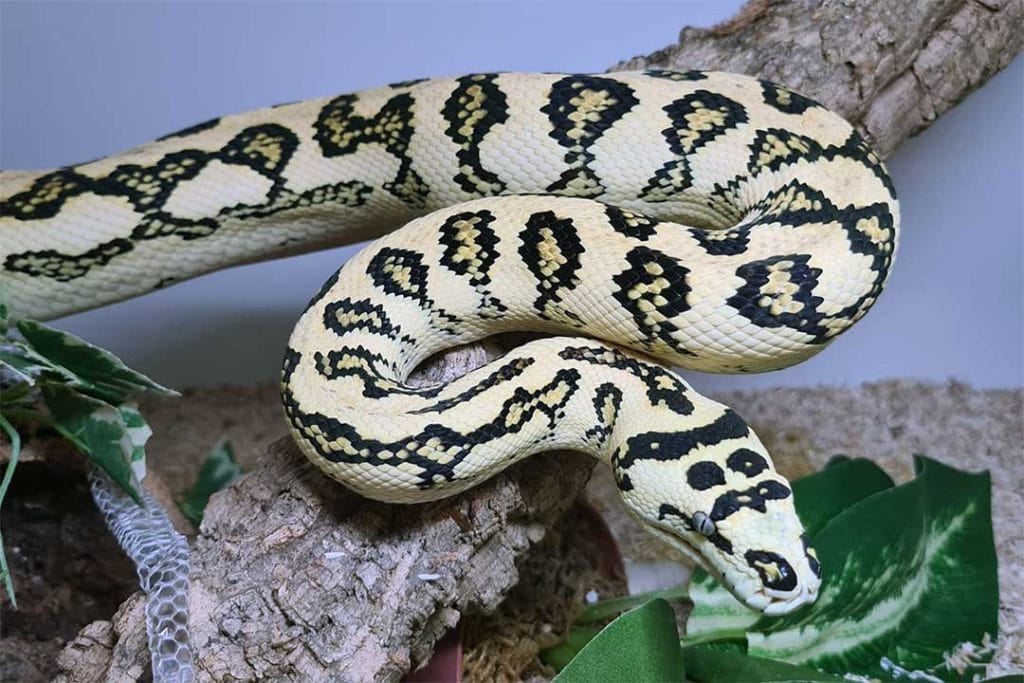
All snakes require heating to help them thermoregulate.
Carpet pythons need around 72 degrees Fahrenheit on the cool side and 85-90 degrees F on the warm side.
Setting up your tank with a temperature gradient is important so that they can regulate their own body temperature.
Under-tank heating works well for this species. You can use radiant heat panels or ceramic heating bulbs for snakes, but they will drastically lower the humidity.
Only use these if you are struggling to control the heat otherwise. Any heating should be plugged into a thermostat to help prevent overheating.
Light
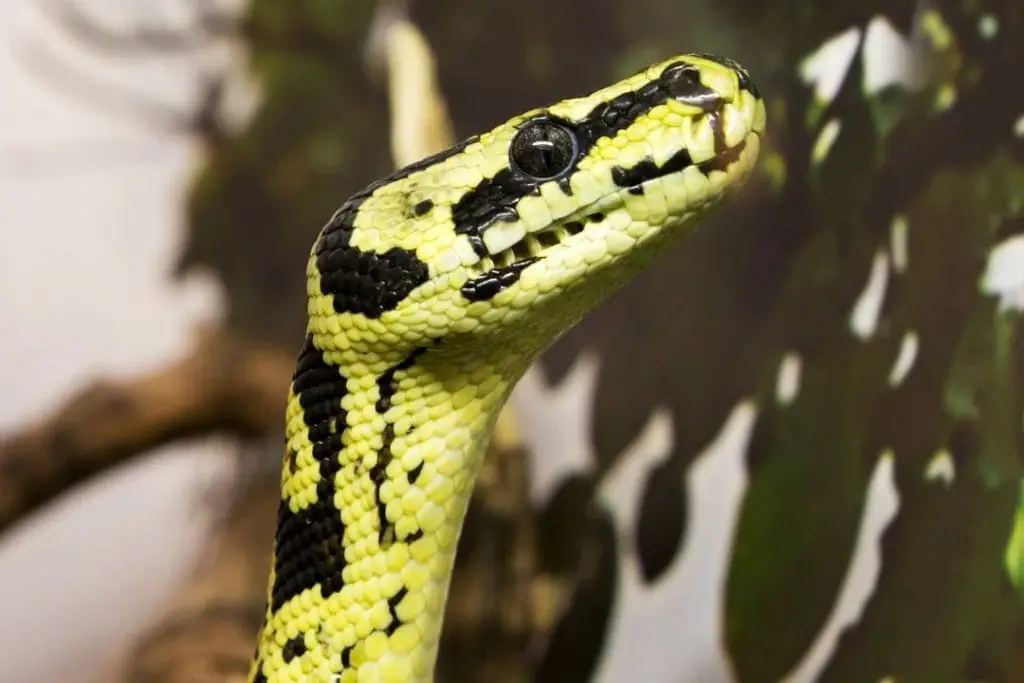
These snakes are typically nocturnal, so they do not need special lighting.
You can use a full-spectrum light if you want to see your snake more easily to appreciate the beautiful looks of these animals.
Any lighting would work, just plug it into a timer and make sure that it doesn’t raise the heat in the enclosure.
Shelter
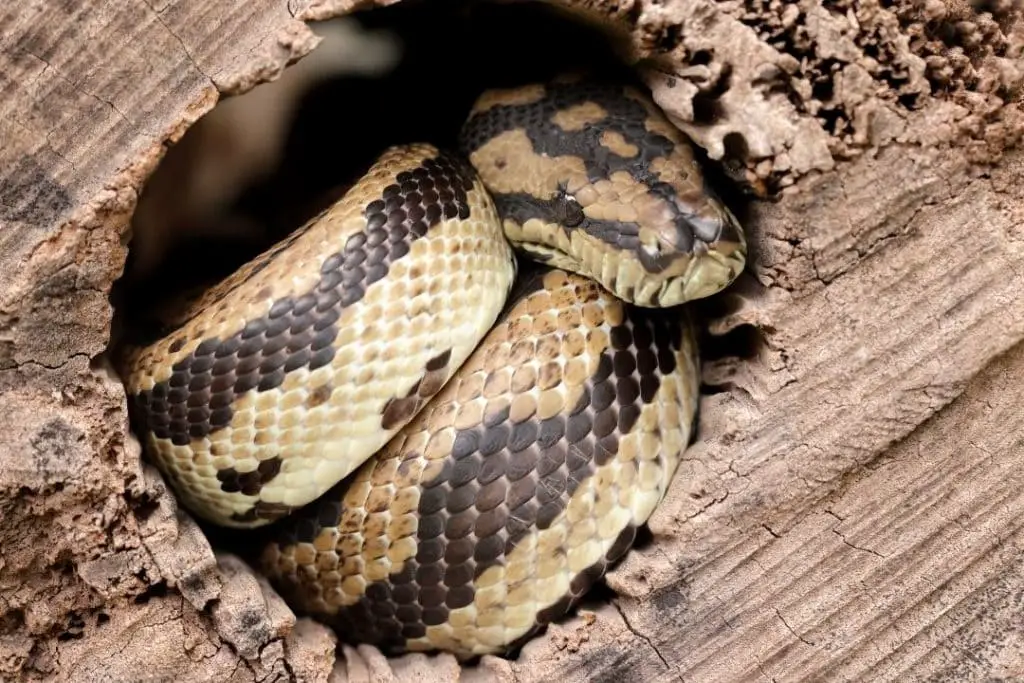
All snakes need at least 2 hides that will hold them completely to feel secure.
Use something with a large enough opening for your snake to enter with ease and do not use open hides like logs since most snakes feel these are too exposed.
You want only one opening. It should also hold the snake without too much extra space.
This can be a great option for adult snakes, and it can function as a humid hide for when your snake is preparing to shed.
Water
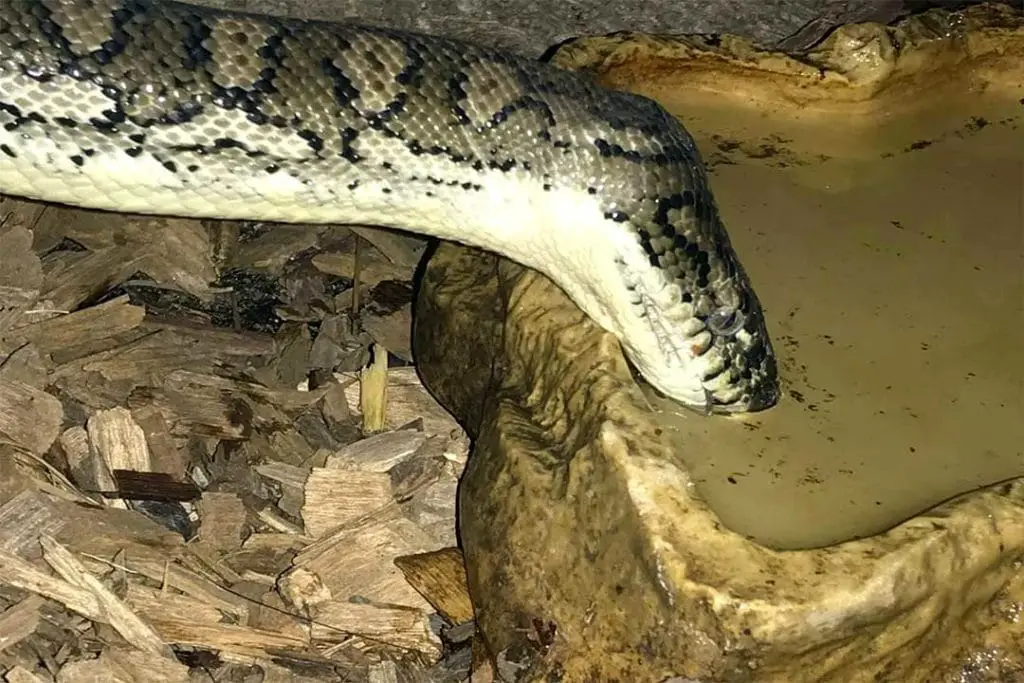
Snakes need plenty of water to drink. Always offer fresh, clean water to your snake. You may notice your snake soaking in its dish, so you want something large enough to fit the whole animal.
This is a good option for a young snake, but you will need something larger for an adult. Just make sure the snake can’t tip it over and flood the enclosure.
Humidity
Jungle Carpet pythons typically don’t need particularly high humidity.
Carpet pythons require around 50% humidity. If you notice it is staying lower than about 45%, mist the enclosure and be sure to offer a humid hide filled with damp sphagnum moss or cypress mulch to help avoid dehydration.
Enclosure Maintenance
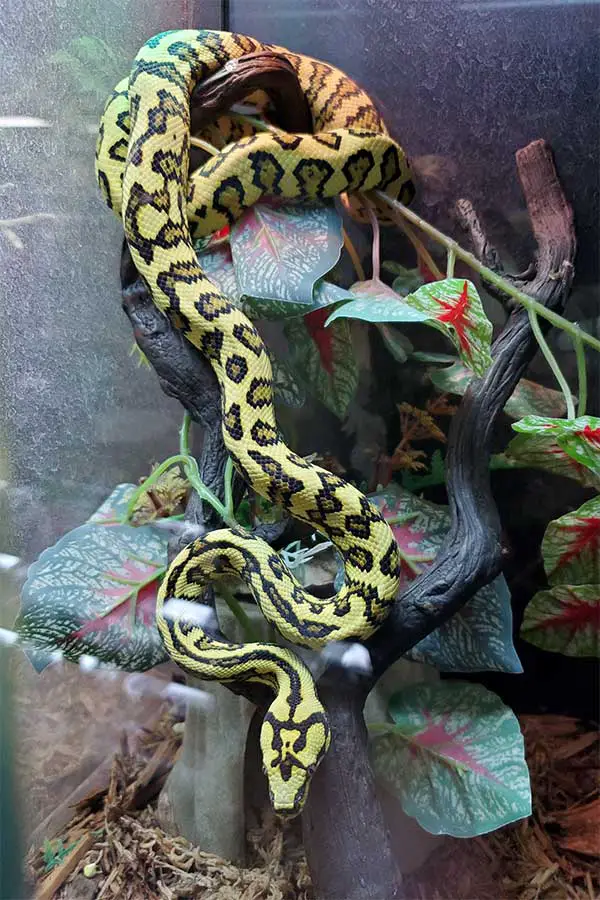
You should be doing spot cleaning and water changes daily. Always check for urates, feces, and spilled water. Clean up the mess and replace any soiled substrate completely.
Since wet substrate can cause skin infections, you need to keep a close eye on this. You should be washing the water dish weekly.
Once a month, you need to put your snake in a spare tub or something similar to allow you to fully clean the enclosure.
A plastic tote with a good lid and holes for ventilation works well, or you can use what you take your snake to the vet in. Turn off all heating and lighting and remove your snake.
Take out and throw away all of your substrates. Set hides and decorations aside for cleaning. Scrub down the enclosure and use a reptile-safe sanitizer to get the enclosure sparkling clean.
If your enclosure is glass, make sure you don’t spray cold liquid on hot glass or it may shatter. Dry up most of the moisture and leave the enclosure open to dry while you clean everything else.
Scrub and sanitize the decorations and water dish. Once these are clean, you can add more substrate, turn on the heating, and replace the decorations.
This is a great time to add new decorations or change the layout a bit to give your snake more mental stimulation. Put your snake back and be sure to lock up well.
Feeding
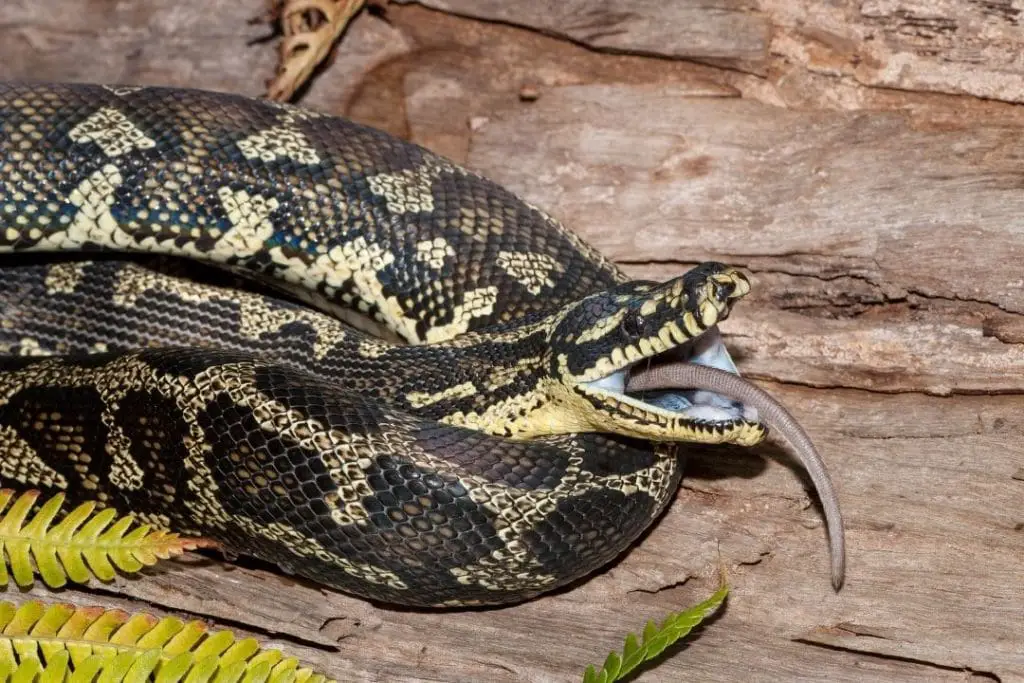
In the wild, carpet pythons will eat nearly anything. Young snakes may go after lizards and small mammals, while an adult irian jaya carpet python will hunt larger mammals and birds. This can include marsupials.
Type and Size of Prey
Feeding properly is an essential aspect of proper carpet python care.
Generally, you will be feeding rodents, quail, or rabbits to captive jungle carpet pythons. Rats are the cheapest and most carpet pythons will take them easily.
Feed juveniles a rat pup that is no wider than the thickest part of the snake.
Go for around 10-15% of your snake’s body weight for prey size. Adult coastal carpet pythons will eat large rats or even rabbits for the largest subspecies.
Frozen vs Live

While many people suggest live food is better for snakes, it comes with risks. Live prey carries parasites and can injure your snake easily.
Rats are notorious for injuring snakes since they are strong and fight back.
Scales do not provide much defense against rat teeth. Live prey is also inconvenient for you since you have to acquire and house a live rat until feeding time.
You have to find a local source for live prey since it is illegal to ship live rodents.
Frozen prey is much easier to find and stock up on. You just need to defrost it in the fridge and warm it up in hot water right before you offer it to your snake.
Keep the rodent in a bag so it stays dry. If your snake refuses to accept anything but live prey, you will need to source your rodents locally.
Frozen rodents can be bought online and shipped to your house.
Most pet stores also keep a stock of frozen feeder rodents. Buying frozen also makes it easy to determine the weight of the prey you will need for your snake.
Frequency
Juveniles need to eat about once a week. An adult will eat about every two weeks or so. Always weigh your snake to monitor its growth.
You should also watch its body condition.
- If you notice that the spine is more prominent, feed your snake more often.
- If you cannot see the spine at all, your snake may be getting fat and you need to feed less often.
You will get a feel for how often your snake needs to eat over time.
Shedding
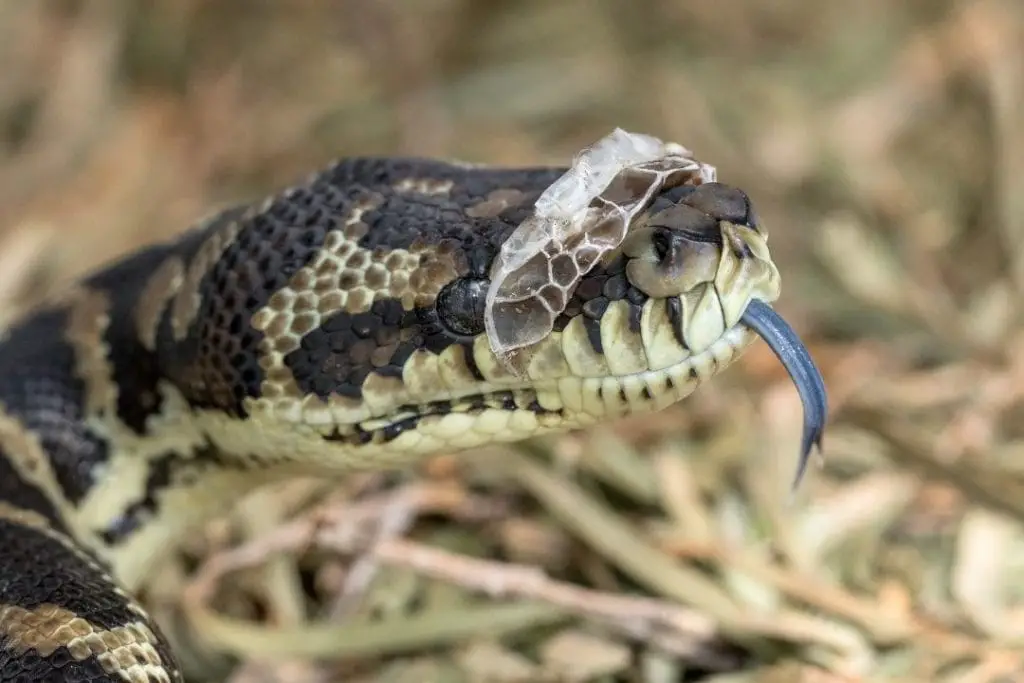
Reptiles shed their skin in one whole piece. You may have seen snake skins for sale. This translucent shed is a single layer of skin.
Your snake needs to shed to grow, since a snake’s skin doesn’t expand much as it grows. Young or injured snakes shed more frequently than adult animals.
When your snake is getting ready to shed, you will notice its colors dull and its eyes become cloudy or blue.
During this time, your carpet python will sleep more often and likely be very grumpy. This is normal. Give your snake a damp hide when you see the signs of an impending shed.
Once your snake sheds, be sure to check the skin. You want a single piece without missing parts.
Be sure to check for the scale that covers the eye and the tail tip since these are the most commonly retained scales.
If your snake does stuck shed, you’ll need the right carpet python care reaction: fill the container you keep it in during enclosure cleans with warm, damp paper towels.
Leave your snake inside for about 15 minutes and check to see if the retained skin can be gently removed.
Hibernation
Carpet pythons do not brumate (see my carpet python facts article). Breeders will lower the night temperatures and change lighting to stimulate the approach of the breeding season.
You do not need to do this unless you will be breeding your snake.
Handling
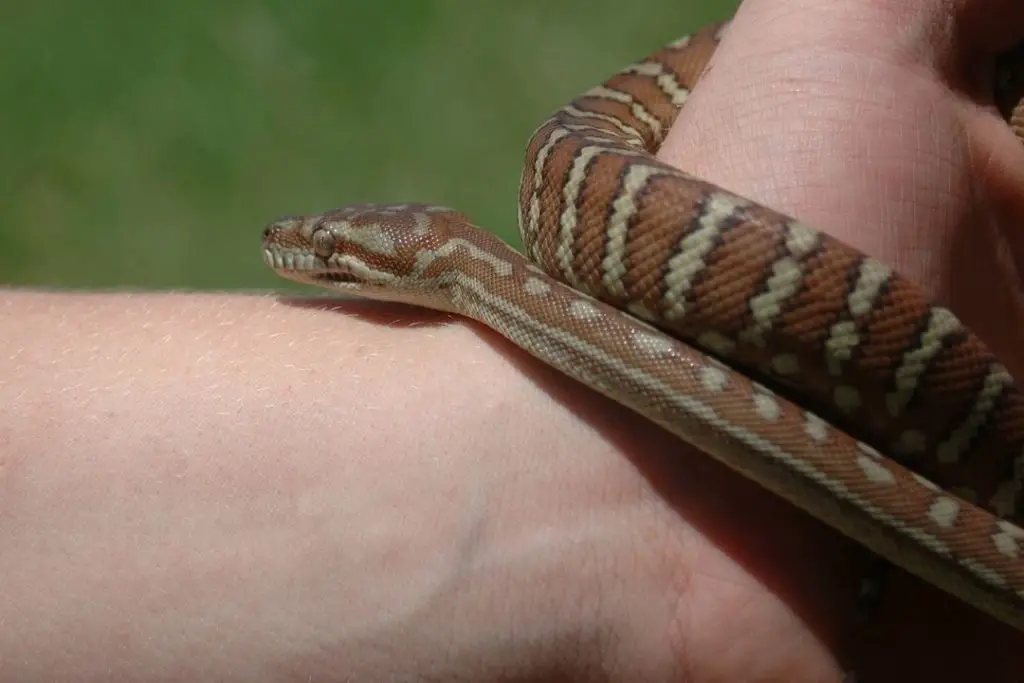
Handling snakes is pretty much the same for snakes under 10 feet long. Never startle your snake, move quickly, or make loud sounds around them.
If you care for your carpet python and want to handle your snake, make sure it is awake. Look for movement and tongue flicking. If you open the enclosure, your snake should take a peek to see what you are up to.
If you don’t see this, your snake may be asleep even if it isn’t in a hide.
Since baby and juvenile carpet pythons are very nippy and all carpet pythons have a strong feeding response, you should hook train your snake.
Snakes are very capable of learning. Whenever it is handling time, gently touch your snake with the back of a snake hook. Then, you can either remove the snake with the hook or lift it with your hands.
If you are afraid of being bitten, use thick gloves and the snake hook. If you hesitate, the snake will assume you are trying to hurt it.
If you are using a snake hook, get it under the mid point of the snake’s body and carefully lift it out of the enclosure. If you are using your hands, approach from the side, slide your hand under the middle of the snake, and gently lift it out.
Support as much of the snake’s body as you can. Carpet pythons are semi-arboreal, so it should hang on, but you do not want to drop it or you will lose trust.
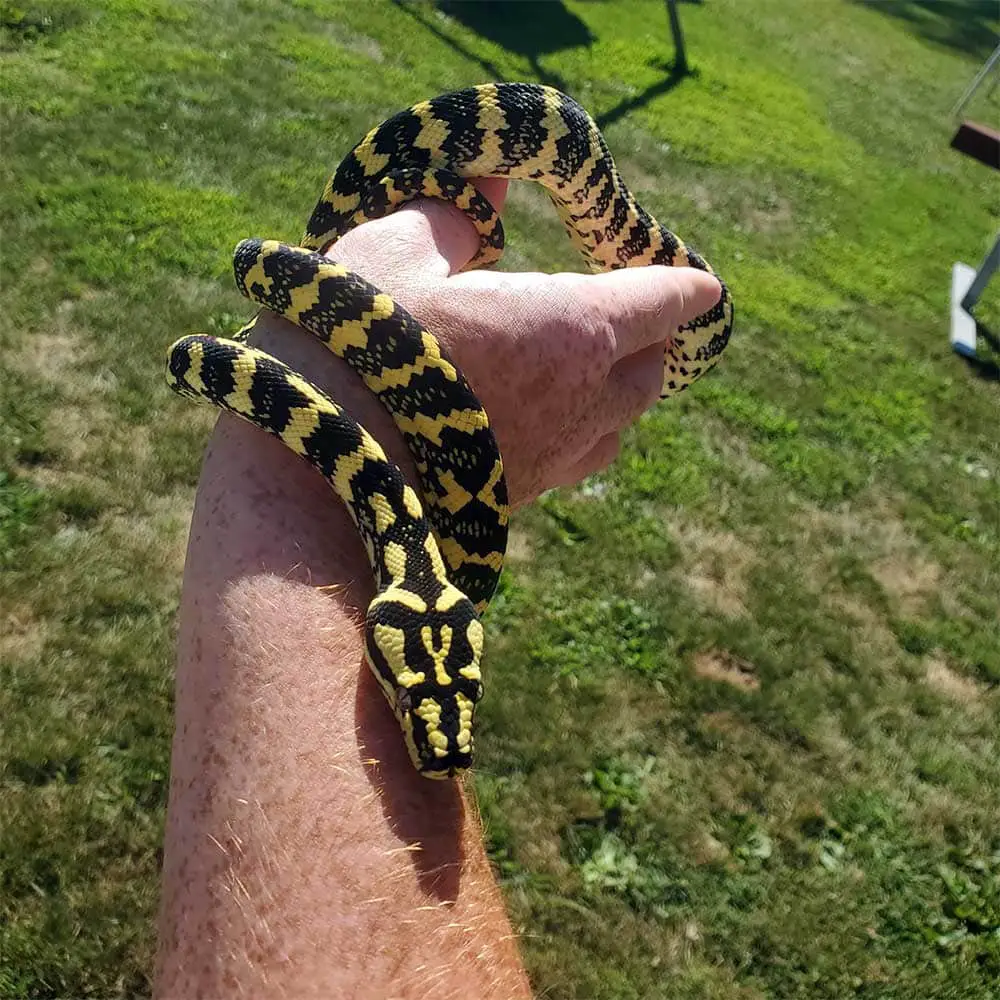
Next, hold the snake loosely and allow it to explore. You can gently guide the snake but do not squeeze or restrain the snake since it will assume you are a predator and fight back.
Young snakes assume this more often and will fight to defend itself. Young carpet pythons do not cause much damage, so do not worry about your snake hurting you while it is young.
Stick with weekly handling sessions when caring for young carpet pythons and only increase them when you know your snake is fine with more frequent handling.
Are Carpet Pythons Aggressive?
In short, no, carpet pythons are not aggressive. Snakes aren’t really aggressive with humans to begin with. Most snakes that are called aggressive are really just defending themselves or have a strong feeding response.
A defensive snake will typically try to flee. Biting is typically a last resort unless the snake has learned that the only way to be left alone is to bite.
A carpet python that has mistaken you for food will typically bite and try to constrict. Carpet pythons have a strong feeding response, so be sure to hook train them and only offer prey on long feeding tongs.
Young carpet pythons are very defensive, but they will calm down with time. Use a snake hook and wear gloves until the snake learns you won’t try to hurt it.
Common Issues
Here are some common concerns for carpet pythons. Read over them, and if you do not see your question answered here, please leave it in the comments.
My Carpet Python isn’t Eating
Carpet pythons rarely go off a meal. They are typically fantastic feeders. Carpet pythons may not eat while they are shedding, so check this first.
Females on eggs and males during the breeding season may not eat.
Otherwise, a sudden feeding strike requires a visit to your reptile vet. Any sudden change in behavior should also be checked out. Snakes are very good at hiding illness, so you want to get your snake checked early.
I also have a more complete article on what to do if your carpet python is not eating.
Regurgitation
Regurgitation is a very serious threat to snakes. Snakes will regurgitate if they are stressed or if the prey item was too large to safely digest.
Check your temperatures in the enclosure with a reliable temperature gun and make sure your snake feels safe and secure.
Make sure your snake has enough hides and give it some quiet for at least 2 weeks before you try to handle your snake or feed it again. Regurgitation can alreadyi be a sign of parasites or other illnesses, so get your snake checked.
Common Illnesses
Snakes can suffer from a number of health problems. First, some colors or morphs of carpet python can have serious health issues.
Always check this before you even consider buying a snake. Next, snakes are prone to mites and ticks. Mites look like little black specs about the size of a poppy seed.
Snakes with external parasites will try to soak them off. Check the water for black specs or drowned ticks and ask your vet for treatments.
Infections are another concern. Look for changes in color such as a pinker belly and any signs or irritation in the mouth or skin. Snakes with infections will also have behavioral changes, so take your snake in if you even suspect an infection.
Respiratory infections are another problem. Look for wheezing, excess mucus, breathing with the mouth open, and behavioral changes.
Once again, this is very treatable, and may be caused by other snakes in your collection or too much humidity. You may also see burns on your snake if it can get too close to your heating sources. This looks much like a burn in humans with reddened areas of skin or blisters.
Be sure that your snake cannot access any heating sources. If you use an under-tank heater, place down a few layer of paper or reptile carpet that your snake cannot get under.
Snakes can overheat very quickly if they lay on a heating element, so be sure they can’t access it.
Bring your snake in for treatment if it gets burned. Your vet can also help you prepare a snake first aid kit in case your pet gets hurt and you cannot immediately take it in. This can save an animal if it gets hurt on a weekend or after office hours for your vet.
My Carpet Python Keeps Biting Me
If your morelia spilota (carpet python scientific name) keeps biting you, you are doing something wrong! Babies and diamond pythons can be very nippy and defensive, but you may be scaring it.
Never grab a snake or squeeze it. Stay calm and pay attention to body language. If your snake is hissing or defensive from the second you open the enclosure, it is telling you it is scared and wants to be left alone.
If this happens a lot, try to give your coastal carpet python some space for 2 weeks before trying again. If your snake is suddenly biting you when it didn’t before, you need to figure out why.
Is the snake in shed? Defending eggs? If it is not, your snake may be in pain and scared. Take it to the vet to make sure it is healthy.
You may also be handling your snake too often. If the vet gives your carpet python a clean bill of health, try giving your snake a few weeks break from handling.
Then, slowly handle again for only a few minutes at a time. If you have just adopted a defensive adult, give it time to relax and get used to you.
Placing a lightly worn piece of clothing like a sock or handkerchief with your scent on it can help your pet learn your scent without the stress of being looked at by a large predator.
Conclusion
Carpet pythons can make great pets. They are beautiful animals, but they can need a lot of space depending on the subspecies you have.
Do plenty of research on your snake and tailor this guide to meet your snake’s needs before getting one or breeding carpet pythons. If you have any questions or comments, please leave them below.
Sources
- Biology of the south‐west carpet python (Morelia spilota imbricata): is there evidence for mesopredator release in response to fox baiting?
- Divergent bornaviruses from Australian carpet pythons with neurological disease date the origin of extant Bornaviridae prior to the end-Cretaceous extinction
- The vulnerable and the endangered: Carpet Python predation on a breeding female Carnaby’s Black Cockatoo
- Habitat use by the inland carpet python (Morelia spilota metcalfei: Pythonidae): Seasonal relationships with habitat structure and prey distribution in a rural landscape
- Records of the Inland Carpet Python, Morelia spilota metcalfei (Serpentes: Pythonidae), from the South-western Slopes of New South Wales
